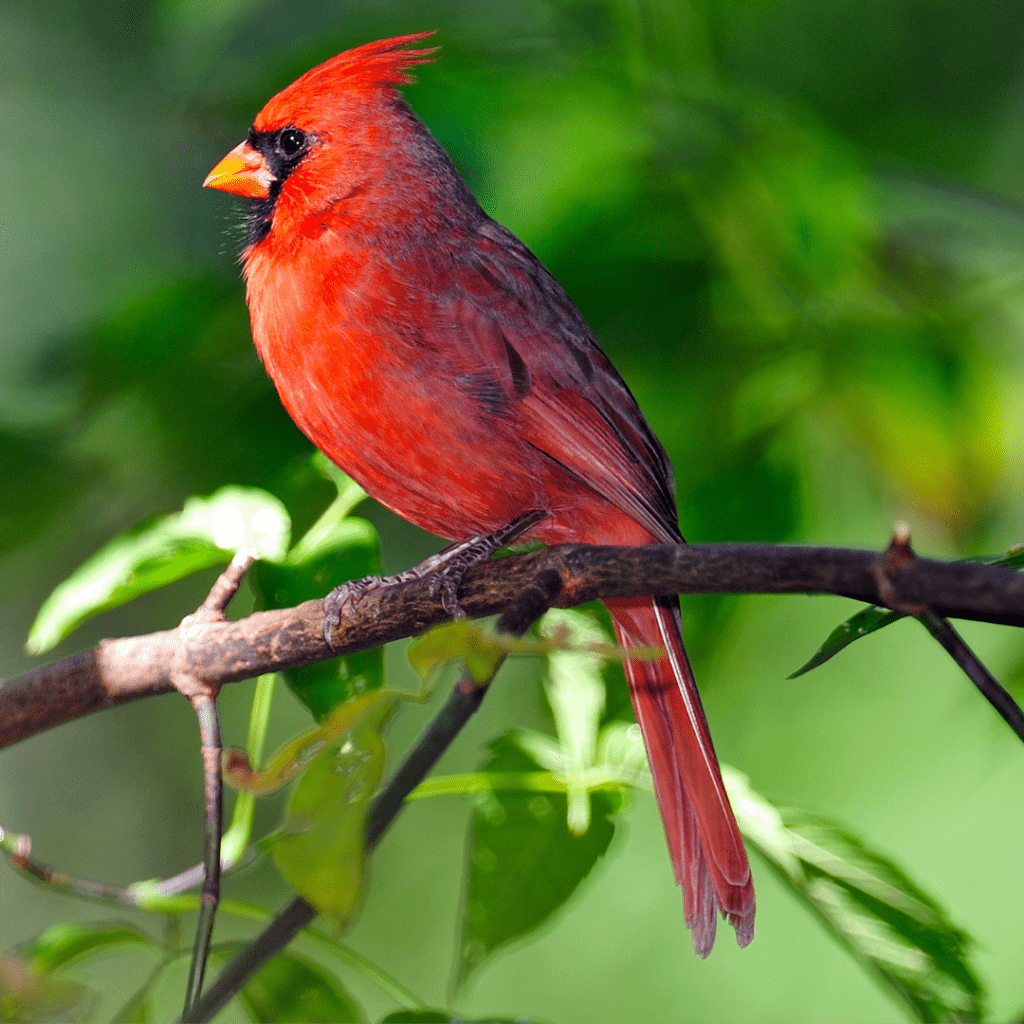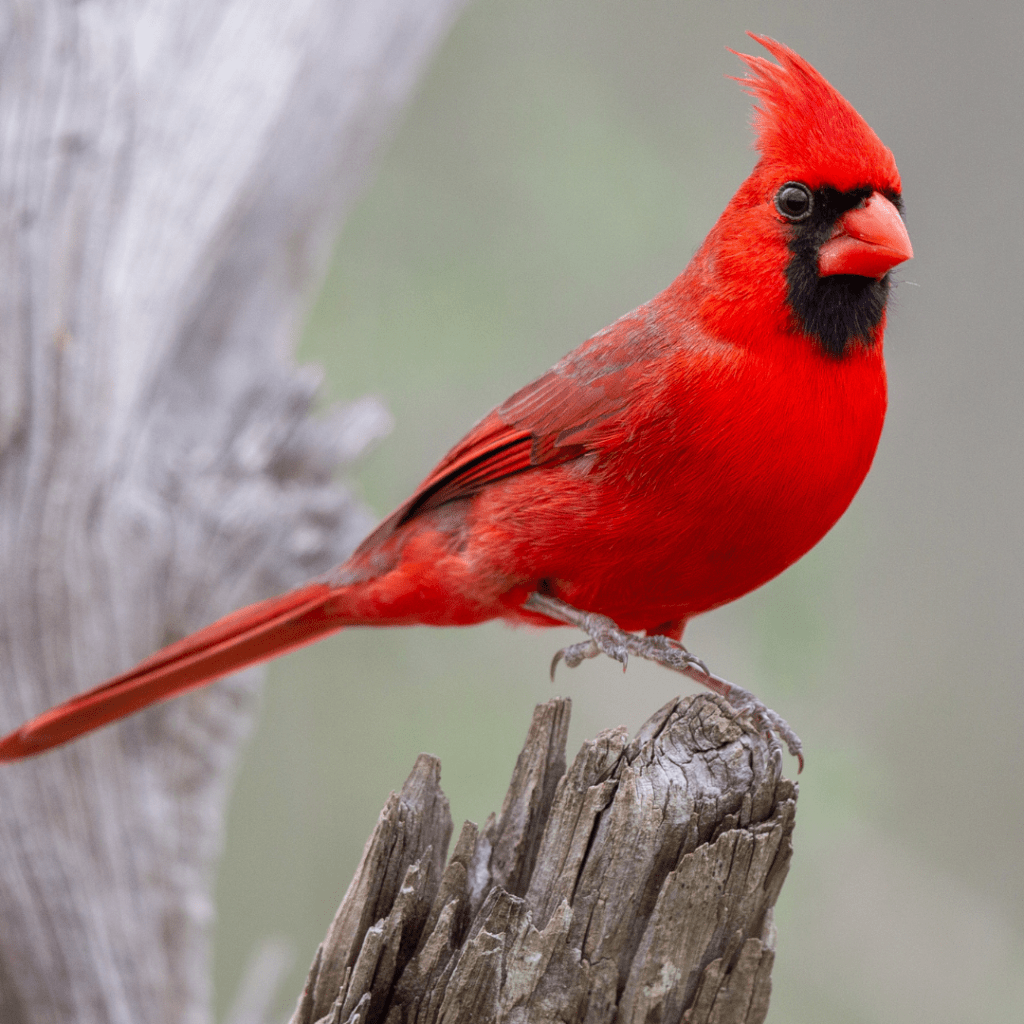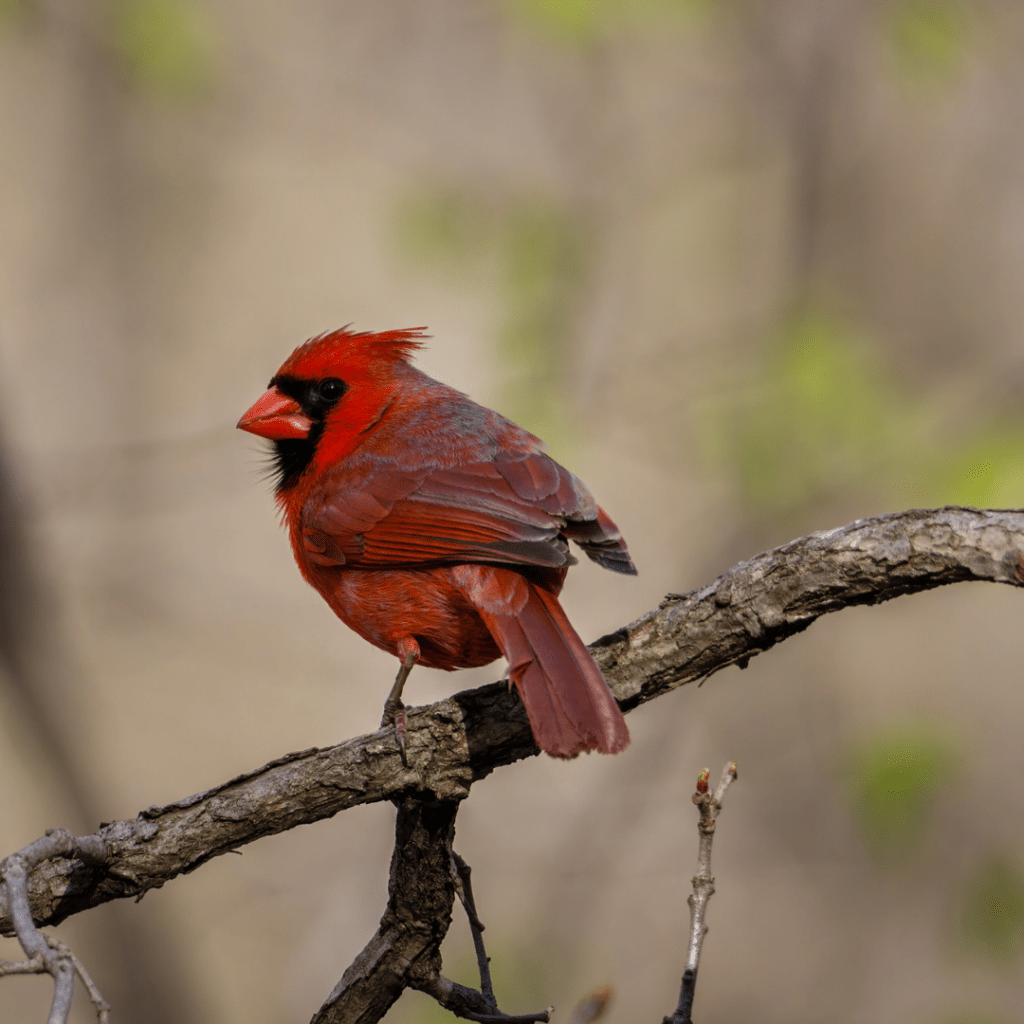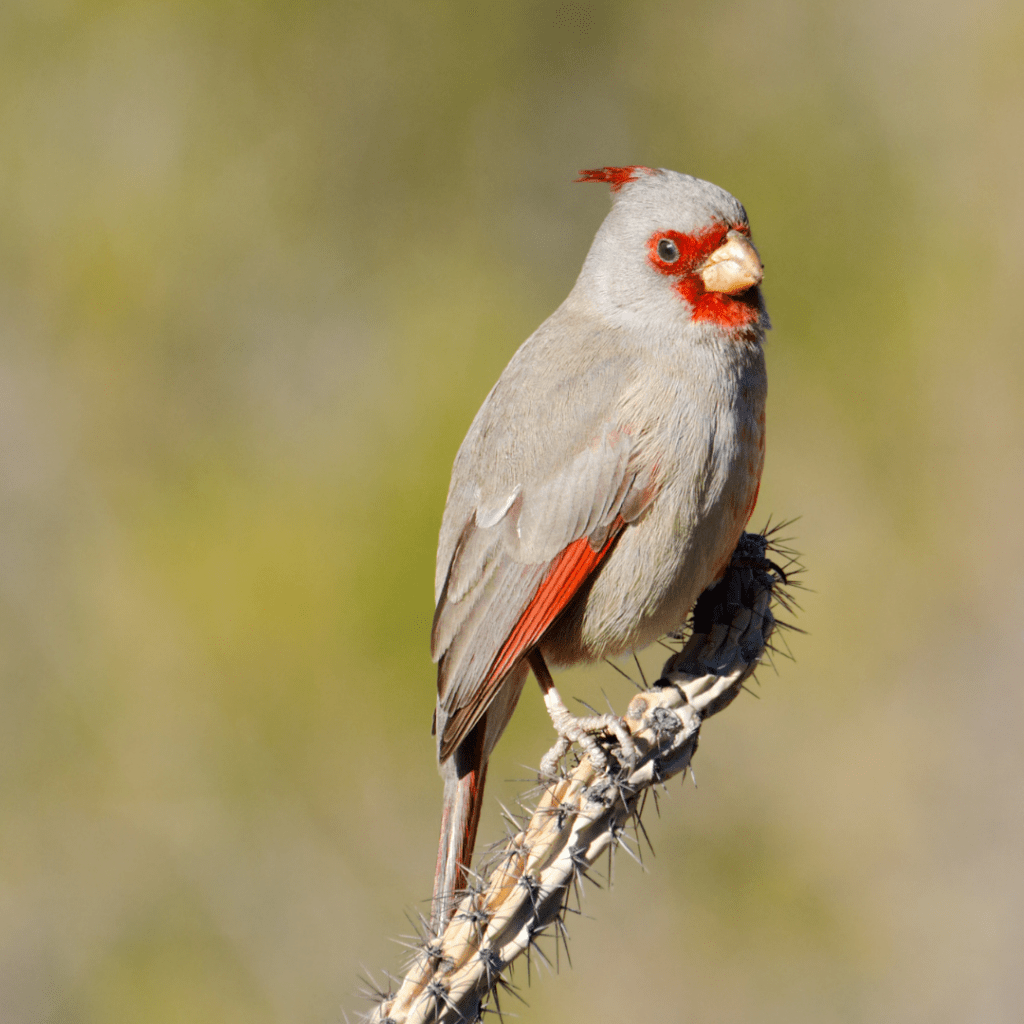Cardinals are brilliant red birds that are noticeable all around North America and even into Central America. The brilliant red cardinals are just the tip of the iceberg, there are many different types of cardinals which you will learn below!
What are Cardinals?

Cardinals are medium-sized birds known for their brilliantly red color and crested heads. These identifiers make them very easy to spot. They are under the genus, or family of cardinalis and are well known all over America even known to travel as far north as Canada and south to central America.
Personally, cardinals are one of my favorite birds since they are fairly common, and have a certain quirk about them! They are quite aggressive when protecting their territory and the red of the males looks almost magically as they soar through the air!
If you are in their habitat then lookout for the next time you are outside, and just to keep in mind, they love sunflower seeds!
Types of Cardinals
There are three main types of cardinals. They all come from the Cardinalidae family which consists of fourteen genera made up of cardinals, buntings, and a few other birds.
They are amazing birds, often experienced bird watchers overlook them, but they are still quite the sight! All of the different types of cardinals are very similar, but with just a few minor differences which we will discuss below!
Northern Cardinal
The northern cardinals are the most well-known type of cardinals. If you see a northern cardinal it signifies happiness and uplifting as their color brings joy to those who are lucky enough!
They are mostly seen and inhabit the eastern part of the United States, but also have been seen in the east of Mexico and into some central American countries.
The Northern cardinal is even the state bird of seven states which shows just how known and loved this bird is all over! It truly is a beacon even on the snowiest and gloomiest days you can see flashes of red as it flys from tree to shrub!

Where do Northern Cardinals Live?
Where do the northern cardinals typically live? Well, the northern cardinals as their name implies are known to be more northern than the other types of cardinals. They are even known to fly as far north as Canada.
Cardinals are year-round birds and don’t migrate, so even in the snowy and cold climates of Canada, it is still usual to see their striking colors. They go even better with a snowy background as well!
They don’t migrate, but they are known to travel if and when food becomes more scarce. So, if you see some northern cardinals in the summer then get out your bird feeder as they will stick around all year if food is plentiful!
What are Northern Cardinals Like?
Other than pooping a lot and doing what birds do! What are they really like? Well, are the Northern Cardinals aggressive?
Well, northern cardinals can become aggressive when protecting and defending their territory. They are known for frequently attacking other male northern cardinals who intrude on their space.
They are even known for attacking windows and mirrors as they see their reflection as a threat. This is why you may see a lot of cardinals hitting and becoming interested in your windows!
Other than protecting their territory they are not known for being very aggressive and are not aggressive towards humans.
The male northern cardinals are very territorial and mark their territory in song. This may be beautiful for us to listen to, but it keeps approaching males at bay and lets them know there is a male cardinal close.
They are known to be in thick hedges and bushes in woodland areas. They nest in dense foliage which makes them especially hard to spot, but their red color makes them easier to depict.
If you see a flash of red and want to go and investigate they like fairly high perches, so make sure to look up high enough!
Breeding
The northern cardinals are unlike any other animal, they breed. They usually raise about two broods a year. The mating season is from May to July and then they also breed from March to September.
Northern Cardinals lay about 2-5 eggs, and they go from being laid to leaving the nest in 18 to 26 days. The Northern Cardinal does not breed for life, in some cases the male and the female break up and find new mates.
They also don’t come back to the same nest every matting season the female typically builds a new nest for the young for every brood, so if you are in dense woodland you may be able to see some abandoned cardinal nest.
Cardinals Bird Colors
What Color are Northern Cardinals?
The male Northern Cardinals are a stunning red color all year long which makes them extra noticeable in the snowy winter months! They have black spots around their faces though and a reddish-orange beak which makes them very distinguishable.
When most people think of cardinals they will probably picture a red cardinal as these are much more known.
They go through molting in the fall which is the only time that they lose their red color. Molting is the process of replacing their old worn feathers with new ones. This doesn’t take too long, and then their red colors are back in full effect.
There was a case of a yellow male cardinal in Illinois that took the even avid and experienced bird watchers by surprise.
This is a rare sight and is due to genetic mutation which is where their bodies fail to convert carotenoids. These are pigments in the food that cardinals eat and when the gene fails it causes the yellow coloration to come through instead of the typical red.
It is a beautiful sight and many members of the birding community were psyched, me included!
People have even to have reported seeing blue cardinals, but as cool as this would be, they don’t exist. Most people just see flashes of blue in the same type of shape as a cardinal and mistake other birds for blue cardinals!
Male vs Female Northern Cardinals
As with most bird species, some distinguishable features can help differentiate male and female cardinals.
We have already gone over the male colors, but you may think that the females would be just as magnificent. Well, I think they are, but they’re not as colorful as their male counterparts.
Female cardinals are a pale brown all over with some reddish tinges in the wings and tail crest. If you are not the best at identifying just yet, don’t worry! We have all been there, they can be differentiated from other brown birds by their red beaks and their hair crest.
The females are also generally smaller than the males, but this is just a slight difference. The males are about an inch bigger than the females.
They both care for their young, in some bird cases one of the mates will abandon the eggs, but male cardinals are actually very caring fathers and will stick around and protect and feed their young.
When a male cardinal is looking for a mate they will use their song to attract one, but male cardinals also feed their mate’s beak to beak. This is to prevent the female northern cardinal from leaving.
What do Northern Cardinals Sound like?
Do Male Northern cardinals sing? Yes, both male and female northern cardinals sing. It sounds like two parted whistles but is quite hard to identify in the field. It speeds up then begins to taper off and continues like this.
Male cardinals tend to sing a bit more than the females and the height of the singing is in the spring and into early summer. This is due to the males defending their territory. Cardinals are songbirds and also use their beautiful song to attract mates.
Vermilion Cardinal
The Vermilion Cardinal is the lesser-known species of cardinal under the Cardinalidae family. They are fairly rare to see and are more or less in northern parts of Venezuela and extreme northeastern Colombia.
They are beautiful birds that are less common, but this doesn’t mean they are any less amazing to see. They are also known as the Venezuelan Cardinal due to their distinct habitat.
Just like the northern cardinal, they spot the same head crest, but they have slightly different colors, which we will go over a little later on!

Where do the Vermilion Cardinals Live?
The Vermilion Cardinal is home to two parts of the very top (north) of the South American continent. They are found from the northeastern part of Columbia into northern Venezuela. They are also found even further east in Venezuela into some islands.
This area of the world is made up of tropical semi-arid shrubland, which is perfect for these cardinals. Instead of the dense forest that the Northern Cardinal enjoys these can be seen flying around cactuses and spiny legumes.
They are found closer to sea level, only getting as high as 980 feet in most cases, but they have been seen in the high spots in Lara which is about 2,300 feet.
They like the desert, which is where they also find various seeds and even insects and worms to eat. The Vermilion Cardinals are not very picky eaters and love sunflowers as a snack (just like most birds!)
What are Vermilion Cardinals Like?
There is not too much unique about the Vermilion Cardinals’ behavior other than the difference from the northern cardinal. They are seen in arid deserts with not much of anything around.
Whereas their northern relatives are seen in dense bushes and forests. They are also very protective over their territory and can be seen challenging other male Vermilion Cardinals if one is coming too close.
Breeding
These cardinals are also devoted birds to their children. The mating season spans a few months from June into early August, with both sexes feeding the young.
They have around 3-4 hatchlings on average with 2-3 broods in most cases a year. Even with all of these extra babies coming into the world, their population is still being challenged by habitat loss and the effects of climate change. They are known to use thermals to soar around looking for the perfect nesting spot though!
What Color are Vermilion Cardinals?
The Vermilion Cardinals look very similar to the northern cardinal in the shape of their bodies and size. They are medium birds, but the Vermilion is a bit smaller, but still considered a medium bird.
The Vermilion is red all over with some black around its face, but its color dullens a bit more so they also can be seen a bit darker and less noticeable red.
Male vs Female Vermilion Cardinals
Both the male and the female Vermilion Cardinals are the same body shape and have the same identifying crest on their heads. The males are red all over, but the females are grayish brown all over with some red accents.
This makes them quite beautiful birds, and it is easy to identify which are female and male. The females are also just a bit smaller than the males, but it isn’t that noticeable.
Pyrrhuloxia or Desert Cardinal

Best till last! These are arguably my favorite cardinals, they are a bit lesser known than your typical cardinal, and they don’t have the striking colors but more of an auburn and gray color with a bright yellow beak.
These little guys are home to well, the desert believe it or not! They are found in the American southwest and into northern Mexico, in the hot arid climate. They are not migrating and will be in a location year-round.
They are in the Cardinalidae family but have very different strengths and habitats than the northern cardinals.
They are foraging birds and can be seen flying around small trees and shrubs looking for food and water. They also forage in small flocks, but no more than about 10.
Where do Pyrrhuloxia Live?
The Pyrrhuloxia is home in very southern parts of the United States, such as some parts of Texas, New Mexico, and Arizona. Then they are most prominent in Mexico, stretching the northern to the middle part of Mexico and going around the Sierra Madre range.
As the name implies they are mostly found in hot desert areas. They can be found in mesquite Savannas, woodlands, scrublands, and farm fields as well. These birds are easily adaptable to the heat and the cold.
This is why they can range in habitat so much, all of these habitats have food for this optimistic omnivore. It will eat insects and other bugs if it can get them, but also sticks to fruits, seeds, and nuts.
63% of the breeding population lives in Mexico with the last 37% living in the United States. They have a population of only 3 million, which is at a decline due to habitat loss.
If you are looking for this bird make sure to look up high enough as it loves to perch on tall trees and cactuses!
What are Desert Cardinals Like?
The Pyrrhuloxia’s behavior is similar to the other cardinals we have covered. It is territorial over its nest and area and will become agitated and aggressive if it sees a threat.
It is a curious bird and flies around foraging for food on the ground near trees, or in the shrubs and other plant life. It is also known to steal and eat fruits from farms in the area. Maybe they do this to get back at the farmers for taking their land… I am not sure though!
It also has a beautiful song that is sung to attract potential mates or to defend its territory. Just like the other cardinals a mate will have certain songs they sign to give the other information.
Such as a certain song telling the male to bring back the food, or that another male is intruding. They always say communication is key, and the cardinals have this covered too!
Pyrrhuloxia Breeding Information
The Pyrrhuloxia cardinals breed for life in some cases, but if it isn’t a great fit then they will break up with their partners and look for other mates.
They raise two broods a year, with the mating season-extending between March and September.
This produces an average of 3-4 eggs but, in some cases, it can be about 2-5 eggs. The incubation period is 14 days, and the nesting period is then about 10 -13 days.
The male also feeds the mother desert cardinal when they are mating and while she is caring for the eggs. This is an effort to prevent the mother from leaving the nest.
What Color are Pyrrhuloxia Cardinals
The Pyrrhuloxia Cardinals’ color is unique and beautiful. It is gratis brown all over, with streaks and tinges of auburn and red on its stomach, tail, and wings. As well as around its face and crest.
It looks magnificent flying around and is easily spottable with its bright yellow beak. The baby cardinals’ colors are usually tan and don’t develop that red color till they are a bit older.
All of them look different and unique with different patterns of red and auburn colors mixed into their otherwise grey feathers. Everyone knows about the red cardinals, but these are truly something special.
Male vs Female Pyrrhuloxia Cardinals
The females are just as gorgeous as the males. They are buffy gray, but they do have quite a lot less red and colored spots than the males.
They still sport that yellow beak though, this makes them a bit harder to differentiate than the other cardinals as both have pretty similar colors. The females though are a bit smaller than the males which make helps when identifying.
Desert Cardinal Song
Since the cardinal is a songbird they have quite an impressive song. It is a whistling sound that tapers off into sound chunks. The song is very similar to the northern cardinals.
The males have over 30 different songs that they use to communicate everything from establishing their territory to communicating with their mates.
If you hear that sound while out in the field then look around and you may catch a glimpse of this amazing bird!
Wrap up
Cardinals are an amazing species of birds that are home to a large portion of the Americas. Ranging from as far north as Canada to the north of Venezuela.
Although they are typically known for the stunning red that northern cardinals have, there are much more colors and beauty in Cardinals than what even meets the eye.
If you are interested in learning more, go out into the field and look around, you may just spot a Cardinal! Happy Birding!

James has always been an avid outdoorsman. Since a kid, he kept a journal of all the different birds and species he saw. Now he wants to share his passion with other birders with Happy Birding!
